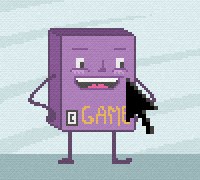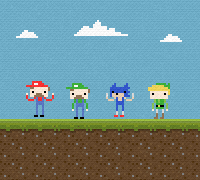“Siri, define Indie!”

So, what are indie games then? After listening to the Cactus keynote at the Berlin A MAZE Indie Festival and watching the various complaints levelled against the EA Indie Bundle, there seem to be lots of reasons to talk about about the meaning of the “indie game” label. And it’s a good question, too. Not even game designers themselves seem to able to define the word whenever we, the press, ask them to. So, what then, are indie games? Games made by independent developers? Affordable, digital-only games? Art projects? 8-bit puzzle platformers? A bad word?
Most people, it seems, love to talk about what indies should be, not about what they are. I’d like to try and explain why Journey and Super Meat Boy can both fit the indie label while Zynga and EA cannot.
Indie is a label that is mainly being associated with four aspects: a developer’s business model, the games’ format, the games themselves and a wibbly-wobbly “indie ethos”. All of these influence whether a developer is perceived as indie or not. Depending on which aspects you see as most important to the idea of indie-ness, different indie models emerge.
The Business Model

Whenever we talk about anti-establishment, artsy and hip indies, we tend to limit ourselves to discussions about dry business models. But there’s a reason for that. Business models seem to be at the forefront of defining what indie games are.
There’s a huge range of people making games, from lone hobbyists coding games for friends to giant companies with hundreds of employees, that are funded by large publishers or may even be publishers themselves (hey Valve). Here’s a rule of thumb: The less developers resemble a “companies” or — God forbid — corporations, the more indie they seem. So, let’s recap: Team Meat are indie, Bioware are not. But the lines between indie and mainstream are so, so blurry. If you use the definition of indie as “game developers independent from publishers”, what do you make of Epic, the creators of shooters such as Gears of War. Epic is a giant independent studio. Yet, considering their size and dependency on traditional forms or distribution, they’re just not comparable to a hobby Flash-game developer. They just don’t fit the same label.
The Format

You download indie games, but mainstream games come in boxes. This is making things way too easy, but it’s part of the expectation towards indie games. They’re small products you get from download stores. They are free or relatively cheap. “Real” games are stuffed into boxes. Indie’s not full price, it’s not 60 dollars worth of game, it doesn’t come with a DVD box. If it does, it better be something very special. Just take a look at the gorgeous boxed copies of Limbo or Binding of Isaac by Head Up Games: They are collectibles. No wonder people get conspicious of games like Serious Sam 3. 40 dollars? Can that still be indie?
The Games

This is where things get exciting. Could indie even be a genre? I’m sure critics and creators would disagree. Yes, indie is a label, not the actual description of a game. It raises expectations, though. Indies are puzzle platformers, chiptunes and chunky pixels, simple game mechanics with complex outcomes. Shooters are not indie, particularly not when they belong to the greyish-brown variety of military manshoots. Indie games tend to have that special something, clearly distinguishing them from more mainstream offerings. There are some non-tangible aesthetics at play, that you can’t find in, say, Gears of War or Assassin’s Creed. The more an indie game resembles a more popular genre, the less it seems to feel indie. And the more it differs from popular indie aesthetics — think hardcore strategy games, Interactive Fiction or old-school RPGs — the less it is perceived as one of the cool indies.
The Ethos

Cactus is indie, Zynga not so much. Why’s that? To pass for an indie, developers need to display a certain attitude towards games and the games industry. They need a slight aversion against publishers and suits (well, or look really cool and casual in a suit). They can use the word “art” when talking about their games, but they’re not required to — as long as they are communicating that their game follows an uncompromised artistic vision. In order to be perceived as indie, developers need to show some disregard for money, unless they are bordering on homelessness. Each step away from this set of values makes it harder to be considered indie. Zynga are evil despite being independent and despite developing cute browser and smartphone games. They are evil, because they bluntly prioritize money over creative vision. If money comes first, neither the format nor the price can change that a developer is not seen as indie.
So, where does this leave us?
Indie is a complex term. It’s firmly connected to developers’ ideas of business, but it also has lots to do with our expectations towards the type of games and the type of people making them. Successful indie designers are shown as a mix between mad coder, artist and punk. This is a difficult role to play — and probably a reason why there are lots of young developers who don’t want to be part of “the scene” ( as much as there are those who do want to be part of it, I suppose). The unwritten rules of indie dictate how people are supposed to behave if they want to fit the label.
This approach to examine indie-ness illustrates why certain developers are indie while others are not. The wonderful thatgamecompany isn’t really independent, but thanks to Jenova Chen and Kellee Santiago’s support of artsy ideas in games as well as their games fitting format (inexpensive, short, digital-only titles), there’s not much protest when their Journey is labelled as indie. At the same time, the harsh critique the EA Indie Bundle got might be confusing to those who are not putting the indie ethos first when defining indie for themselves.
Does all this now make the indie label okay all of sudden? Nope. It remains a label that’s just as helpful as it is problematic. However, we should be aware of what exactly we mean when we say “indie game”. Ultimately, the indie label should help developers, not hinder them in their ideas and their approaches to game development.